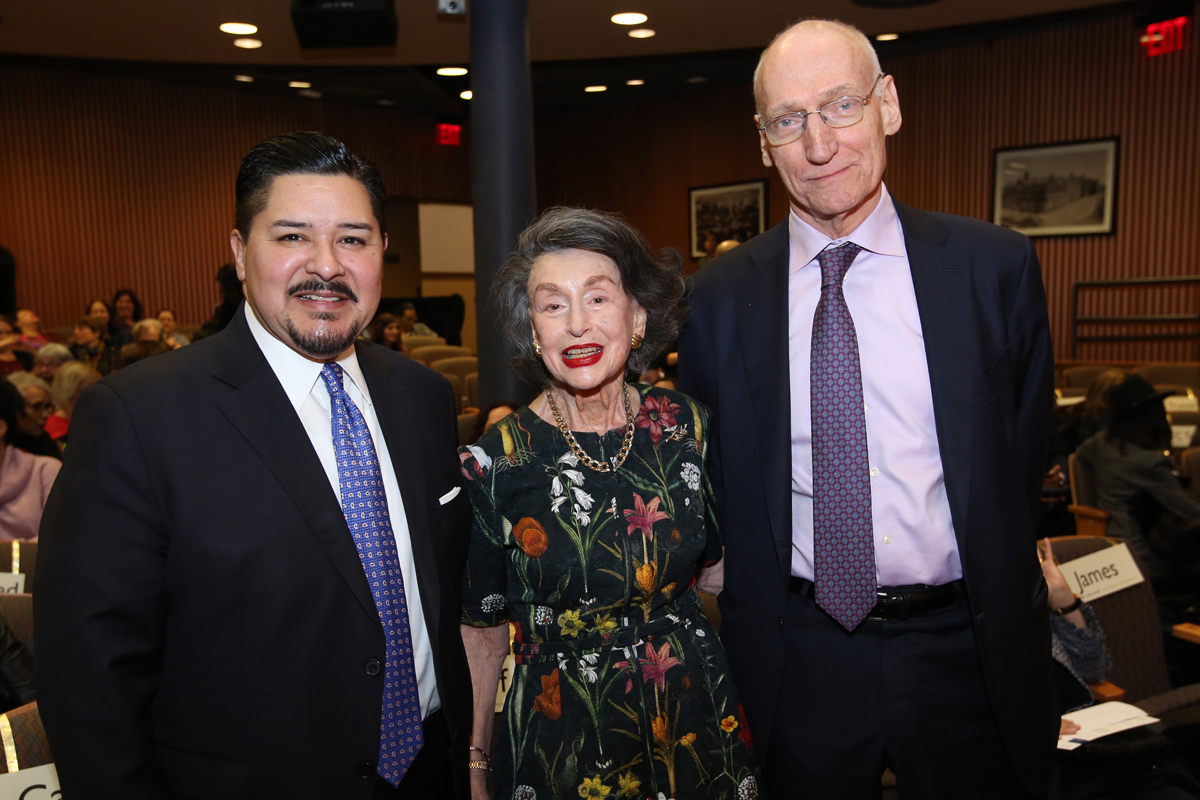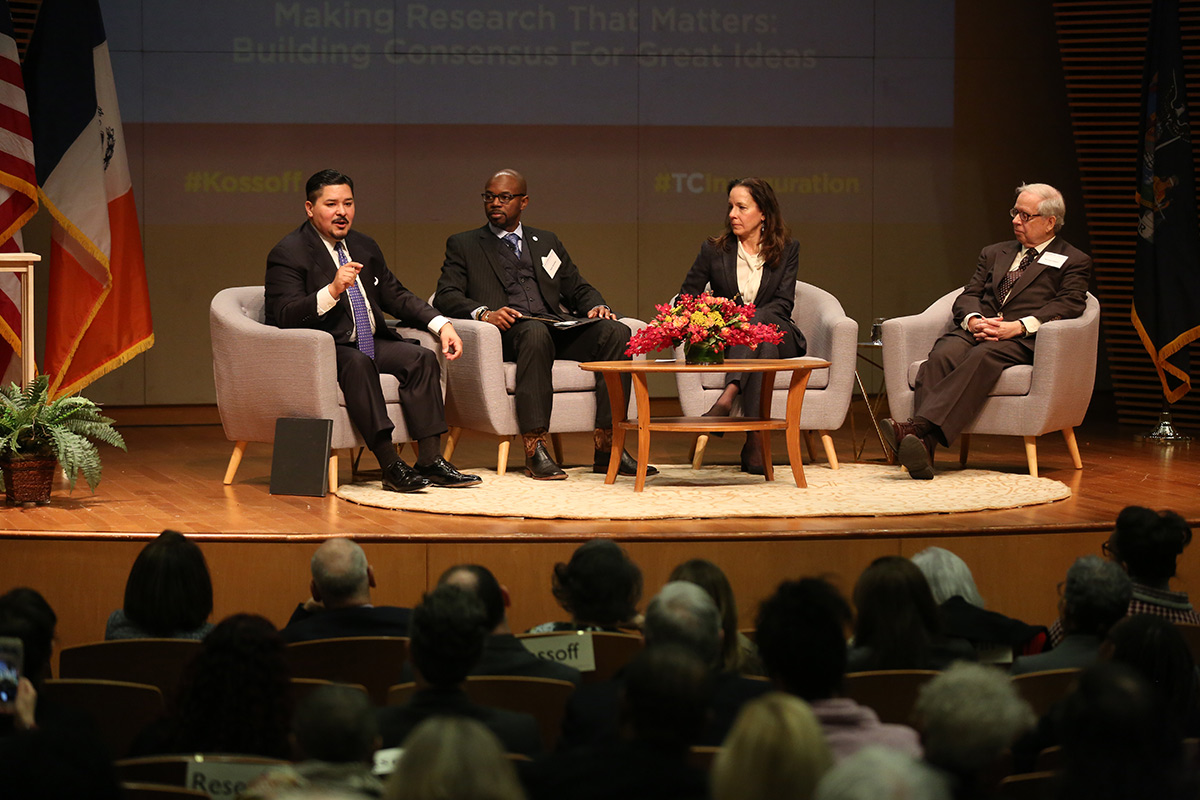When New York City Public Schools Chancellor Richard Carranza stepped to the podium to deliver TC’s 2018 Phyllis L. Kossoff Lecture on Education & Policy, he paid some compliments to the College and its new President, Thomas Bailey. He thanked his wife for being there and cracked a couple of jokes. And then, for the next two minutes, he spoke in Spanish.
When he finished, he paused to let the experience sink in. “I’m not trying to be rude,” he said. “But I want to ground us in the conversation we’re going to have today. As we speak, thousands of students who are English language learners are having that experience today in public schools in New York City.”
Over the next hour, Carranza, who last April took charge of the nation’s largest public school system after serving as schools chancellor in Houston, proceeded to make the case for the signature focus of his administration.
MAKING EQUITY HIS FOCUS Richard Carranza, Chancellor of New York City's Public Schools, delivered the 2018 Phyllis L, Kossoff Lecture in Education & Policy.
“My priority for this school year — and every moment I’m New York City Schools Chancellor — is to advance equity now,” Carranza told a Cowin Auditorium audience of TC administrators, faculty, students, staff and alumni. “In New York City, equity means that we have the same high expectations for all our students, whatever their race, ethnicity or zip code.”
The annual Kossoff Lecture is made possible by a gift from TC alumna and President’s Advisory Council member Phyllis L. Kossoff, whom Carranza publicly thanked and praised from the stage. The lecture was the centerpiece of an academic symposium held as part of a week of events and festivities culminating in Bailey’s inauguration as TC’s 11th President.
To promote equity, Carranza said, it’s necessary to acknowledge “the elephant in the room — segregation.”

Richard A. Carranza, Phyllis L. Kossoff, and Tom Bailey
“A public, and I underline, public school system should represent the entire city it serves,” Carranza said. “In New York City, just as in other cities I’ve worked in, that’s often not the case.”
Carranza has made headlines during his brief New York City tenure with a proposal to change the admissions process in order to promote greater student diversity at the city’s eight specialized high schools, and he cited the current makeup of those schools as exhibit A of the system’s inequities. At the elite Stuyvesant High School, for example, just three percent of this year’s incoming students are black.
“In a city like New York City, with a public school system like New York City’s system, how can that be OK?” he asked. “Either the students are biologically, genealogically, psychologically incapable of being admitted to a school like Stuyvesant — or perhaps there are systems and structures to identify students for that opportunity that are not calibrated to who our students are.”
Carranza cast blame more specifically on “long-established” screening processes that discourage applications by students living in under-served households.
“A public, and I underline, public school system should represent the entire city it serves,” Carranza said. “In New York City, just as in other cities I’ve worked in, that’s often not the case.”
—Richard Carranza
“The inequities born of segregation follow students throughout their lives, disadvantaging them both socially and economically,” he said. “Equity means acknowledging that some students need more help than others and that we give them the support they need to succeed. You know, in my nearly 30 years in education, people say, ‘The issue isn’t money; we can’t just throw money at the issue.’ Well, just once, I wish someone would throw money at the issue and give us the opportunity to prove them wrong.”
Carranza’s measures for achieving equity start with the city's commitment to early education, “3-K for All,” that sets the stage for a “Universal Literacy” initiative that aims to have all New York 2nd graders reading at grade level by 2026.
Variations on the early education theme — “Algebra for All,” “Computer Science for All,” “Advanced Placement for All” and “College Access for All” — have been implemented to guide students through elementary, middle and high school.
“In my nearly 30 years in education, people say, ‘The issue isn’t money, we can’t just throw money at the issue.’ Well, just once, I wish someone would through money at the issue and give us the opportunity to prove them wrong.”
—Richard Carranza
To supplement the learning initiatives, Carranza has mandated that 125,000 teachers, administrators and other members of the city-wide instructional staff participate in anti-bias training between now and 2022.
He said the training is designed to help teachers and administrators see one another, students and parents “as people, not as a demographic. This is a powerful way to break down stereotypes.”
The Chancellor also called for schools to redouble the inclusion of culturally relevant education in curriculum.
“Culturally relevant education brings learning to life for students,” Carranza said. “Learning about authors, leaders, great people who look like they do, who grew up like they did, can propel children to success.”
The Chancellor spoke further about cultural relevance in a conversation with TC faculty following the lecture.
Responding to a question from Professor of Sociology & Education Amy Stuart Wells on what New York City can learn from successes in ethnically focused curriculum in Southwest schools, Carranza said the process begins with a fundamental understanding of what sets communities apart from one another.
“Culturally relevant education brings learning to life for students,” Carranza said. “Learning about authors, leaders, great people who look like they do, who grew up like they did, can propel children to success.”
—Richard Carranza
“Ethnic studies need to be connected to the idiosyncrasy of each community,” he pointed out.
The leadership of urban schools likewise demands a deep grasp of the factors that shape young people beyond the classroom, Carranza said in response to a question posed by Christian Johnson Endeavor Professor of Education Leadership Mark Gooden.
“Kids cannot be academically challenged unless they feel safe, supported in a school environment,” the Chancellor explained. “And that, with the exception of Teachers College, is not something learned in traditional leadership education programs.”
The issues students bring to school from home and the street, he added, “make all the difference in communities of color and among under-served populations.”
Michael Rebell, Professor of Law & Educational Practice, who led a lawsuit that in 2006 won New York City billions of additional dollars in school funding from New York State, inquired about Carranza’s spending priorities when New York Governor Andrew Cuomo releases an anticipated $1.5 billion in funds from that ruling.
“$1.5 billion isn’t enough,” said Carranza, citing the need for extra teachers to lower class sizes, expanding social worker and counseling services, adding fine arts and a litany of other programs to bolster equity and learning.
But Carranza promised to spend the money wisely:
“If we don’t, the payment we will have to make it up later in terms of incarceration, loss of tax dollars, loss of GDP will be much more than $1.5 billion. So we either invest now or we most assuredly will pay much more later.”
